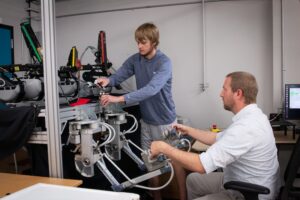The demand for qualified medical practitioners and surgeons is expected to increase twofold within the next decade, as professionals are retiring faster than new ones enter the field, and the population continues to age. These factors place increasing stress on doctors and patients alike and have prompted a hunt for solutions.

New research co-authored by a University of Utah computer scientist explores how artificial intelligence (AI) can help alleviate this crunch by using it to deploy medical needles within the body.
For decades, surgeons have been guided by imagery produced by computed tomography, ultrasound and magnetic resonance as they operate, but rapid advances in AI are now opening new avenues for high-precision procedures where there is little room for error, according to Alan Kuntz, who helped write a comprehensive review of prior research, published this month in Science Robotics.
“AI in this context is not this monolithic intelligent agent that’s performing all of these tasks. It’s not an artificial surgeon. We look at targeted locations in which these kinds of technologies can be inserted into the surgical or interventional workflow in order to improve a piece of capability there,” said Kuntz, an assistant professor in the Kahlert School of Computing and a member of the U’s Robotics Center. “Where are the places in a typical needle-based intervention where these tools are appropriate? How have people used these tools in those places? And then what can we learn? What are the next steps?”
Continue reading Ethan Hood’s “Is there a place for AI in placing medical needles?” on @TheU.